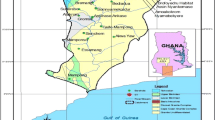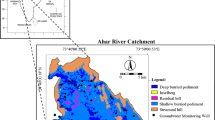Abstract
In most arid zones, groundwater (GW) is the major source of domestic, agriculture, drinking, and industrial water. Accordingly, the monitoring of its quality by different techniques and tools is a vital issue. The purpose of this paper is the evaluation of the combination of principal components analysis (PCA) and geostatistics as a technique for (1) identifying the processes affecting the groundwater chemistry of the detrital unconfined Middle Miocene Aquifer (MMA) of the Hajeb elyoun Jelma (HJ) aquifer (Tunisia) and (2) mapping the controlling variables for groundwater quality. This work is based on a limited database recorded in 22 wells tapping the aquifer and unequally distributed in the field. The proposed approach is carried out in two steps. In the first step, the application of PCA revealed that rock–water interaction, agriculture irrigation and domestic effluents could explain 85 % of the observed variability of the chemical GW quality of the MMA. As a result, two new variables are defined: V1 (rock–water interaction influence) and V2 (irrigation and domestic effluent influence). In the second step, the spatial variability of these variables over the extent of the MMA is mapped by applying a kriging interpolation technique. The results of this study suggest that, while both natural and anthropogenic processes contribute to the GW quality of the MMA, natural impacts can be considered as the most important.








Similar content being viewed by others
References
Abid K, Zouari K, Dulinski M, Chkir N, Abidi B (2010) Hydrologic and geologic factors controlling groundwater geochemistry in the Turonian aquifer (southern Tunisia). Hydrogeol J 19(2):415–427
Ahmadi and Sedghamiz (2008) Application and evaluation of kriging and cokriging methods on groundwater depth mapping. Environ Monit Assess 138:357–368
Burrolet PF (1956) Contribution à l’étude stratigraphique de la Tunisie centrale, Annales des Mines et de la Géologie (in French) No. 18, p 350
Cambardella C, Moorman T, Novak J, Parkin T, Karlen D, Turco R (1994) Field scale variability of soil properties in Central Iowa soils. Vol. 58, No. 5, Soil Science Society of America, Madison pp 1501–1511
Cloutier V, Lefebvre R, Therrien R, Savard M (2008) Multivariate statistical analysis of geochemical data as indicative of the hydrogeochemical evolution of groundwater in a sedimentary rock aquifer system. J Hydrol 353:294–313
Dassi L, Zouari K, Peter Seiler K, Faye S, Kamel S (2005) Flow exchange between the deep and shallow groundwaters in the Sbeïtla synclinal basin (Tunisia): an isotopic approach. Environ Geol 47(4):501–511
Davis JC (1986) Statistics and data analysis in geology. Wiley, New York
Espinosa RJ, Sousa AJ, Chica-Olmo M (1993) Identification of geochemical anomalies using principal components analysis and factorial kriging analysis. J Geochem Explor 46:245–256
Goovaerts P (1997) Geostatistics for natural resources evaluation. Oxford, New York
Güler C, Thyne GD, McCray JE, Turner AK (2002) Evaluation of the graphical and multivariate statistical methods for classification of water chemistry data. Hydrogeology 10:455–474
Hachicha W, Masmoudi F, Haddar M (2008) Formation of machine groups and part families in cellular manufacturing systems using a correlation analysis approach. Int J Adv Manuf Technol 36(11–12):1157–1169
Hamzaoui FA, Bouhlila R, Gueddari M (2009) Geochemistry of fluoride and major ion in the groundwater samples of triassic aquifer (South Eastern Tunisia), through multivariate and hydrochemical techniques. J Appl Sci Res 5(11):1941–1951
Harmouzi O (2010) Reconnaissance détaillée de la partie nord-est du Bassin de Saïss (MAROC): interprétation de sondages électriques verticaux par combinaison des méthodes statistique, géostatistique et d’inversion. (in French) Thèse de doctorat. Univ Moulay Ismail-Univ Bordeaux 1
Jiang Y, Wu Y, Groves Ch, Yuan D, Kambesis P (2009) Natural and anthropogenic factors affecting the groundwater quality Nandong karst underground river system in Yunan, China. J Contam Hydrol 109:49–61
Kaiser HF (1960) The application of electronic computers to factor analysis. Educ Psychol Meas 20:141–151
Koshel R (1980) Etude hydrogéologique de la nappe de Hajeb El Aïoun–Djelma–Ouled Asker. Edition spéciale de la Direction des Ressources en Eau et en Sol, Division des Ressources en Eau. Projet N° 6520/7 (in French) p 245
Lefohn AS, Knudsen HP, Shadwick DS (2005) Using Ordinary Kriging to Estimate the Seasonal W126, and N100 24-h Concentrations for the Year 2000 and 2003. A.S.L. and Associates, 111 North Last Chance Gulch Suite 4A Helena, Montana 59601
Maliva R, Missmer T (2012) Arid lands water evaluation and mangement. Environmental Science and Engineering. Springer-Verlag Berlin, Heidelberg. doi:10.1007/978-3-642-29104-3_2
Maoui A, Kherici N, Derradji F (2009) Hydrochemistry of an Albian sandstone aquifer in a semi arid region, Ain oussera, Algeria. Environ Geol 60(4):689–701
Matheron (1970) La théorie des variables régionalisées et ses applications. les cahiers du centre de morphologie mathématique de Fontainbleau, fascicule 5, Ecole Nationale Supérieur des mines Paris, pp 211 (English version is available from the same publisher since 1971)
Ogasawara H (1999) Standard errors for the direct oblimin solution with Kaiser’s normalization. Shinrigaku Kenkyu 70(4):333–338
Saidi S, Bouri S, Ben Dhia H (2009) Groundwater vulnerability and risk mapping of the Hajeb-Jelma aquifer (Central Tunisia) using a GIS-based DRASTIC model. Environ Earth Sci 59(7):1579–1588
Sanchez-Martoz F, Jiménez ER, Pulido BA (2001) Mapping groundwater quality variables using PCA and geostatistics: a case study of Bajo Andarax, southeastern Spain. Hydrol Sci J 46(2):227–242
Ta’any RA, Tahboub AB, Saffarini GA (2009) Geostatistical analysis of spatiotemporal variability of groundwater level fluctuations in Amman–Zarqa basin, Jordan: a case study. Environ Geol 57(3):525–535
Uyan M, Cay T (2010) Geostatistical methods for mapping groundwater nitrate concentrations. 3rd International conference on cartography and GIS 15–20 June, 2010, Nessebar, Bulgaria
Wackernagel H (1995) Multivariate geostatistics: an introduction with applications. Springer, Berlin
World Health Organization (WHO) (1993) Guidelines for drinking water quality, recommendations, vol. 1, Geneva, p 1308
Wunderlin DA, Diaz MP, Ame MV, Pesce SF, Hued AC, Bistoni MA (2001) Pattern recognition techniques for the evaluation of spatial and temporal variations in water quality. A case study: Suquia river basin (Cordoba-Argentina). Water Res 35:2881–2894
Yamamoto JK (2005) Comparing ordinary kriging interpolation variance and indicator kriging conditional variance for assessing uncertainties at unsampled locations. In: Dessureault S, Ganguli R, Kecojevic V, Dwyer JG (eds) Application of computers and operations research in the mineral industry, Balkema
Yidana SM, Banoeng-Yakubo B, Akabzaa TM (2010) Analysis of groundwater quality using multivariate and spatial analyses in the Keta basin, Ghana. J Afr Earth Sci 58(2):220–234
Zammouri M (1988) Modèle de simulation des nappes de Hajeb El Youn-Jelma-Ouled Askar Report (in French). DGRE Tunis
Zekai C (2008) Wadi Hydrology, Chapter 6. In: Groundwater management methods for arid regions (ed.) Taylor and Francis, London, pp 243–301
Zouari K, Mamou A (1998) Etude isotopique et hydrochimique des systèmes multicouches de Gafsa et de Hajeb El Youn. (in French) Rapport final de Projet (AIEA)
Acknowledgments
The authors warmly thank the anonymous reviewers for their detailed and constructive criticisms, which were of great help in improving this manuscript. The authors also wish to express their thanks to Mr. Elhoucine Essefi from the National Engineering School of Sfax for carefully editing and proofreading English of the present study.
Author information
Authors and Affiliations
Corresponding author
Electronic supplementary material
Below is the link to the electronic supplementary material.
Rights and permissions
About this article
Cite this article
Kolsi, S.H., Bouri, S., Hachicha, W. et al. Implementation and evaluation of multivariate analysis for groundwater hydrochemistry assessment in arid environments: a case study of Hajeb Elyoun–Jelma, Central Tunisia. Environ Earth Sci 70, 2215–2224 (2013). https://doi.org/10.1007/s12665-013-2377-0
Received:
Accepted:
Published:
Issue Date:
DOI: https://doi.org/10.1007/s12665-013-2377-0




